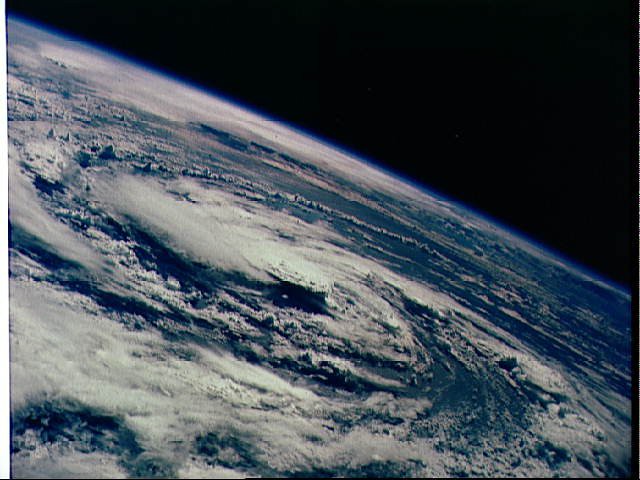Here’s a great short video for those who like to think science is settled on global warming/climate change, as only one example of hubris despite our limited understanding of natural phenomena. Further on is a discussion of the climate system we see as chaotic, another way of saying its behavior surpasses our understanding.
Readers here will know that I report frequently on the changes in Arctic ice extents during the year. So I was impressed to learn about fundamental mysteries underlying even this ordinary process. We do know a lot about the phase change of liquid water into ice. And we have a theoretical law that is predictable, but only when water is absolutely pure, i.e. only H2O with no gases or impurities dissolved in the sample. As the researcher explains, almost all of the water in nature has impurities and thus parts of the process are still beyond our scientific knowledge.
Our Chaotic Climate System
h/t tom0mason for inspiring this post, including his comment below

Foucault’s pendulum in the Panthéon, Paris
The Pendulum is Settled Science
I attended North Phoenix High School (Go Mustangs!) where students took their required physics class from a wild and crazy guy. Decades later alumni who don’t remember his name still reminisce about “the crazy science teacher with the bowling ball.”
To demonstrate the law of conservation of energy, he required each and every student to stand on a ladder in one corner of the classroom. Attached to a hook in the center of the rather high ceiling was a rope with a bowling ball on the other end. The student held the ball to his/her nose and then released it, being careful to hold still afterwards.
The 16 pound ball traveled majestically diagonally across the room and equally impressively returned along the same path. The proof of concept was established when the ball stopped before hitting your nose (though not by much). In those days we learned to trust science and didn’t need to go out marching to signal some abstract virtue.
The equations for pendulums are centuries old and can predict the position of the ball at any point in time based on the mass of the object, length of the rope and starting position.
Pictured above is the currently operating Foucault pendulum that exactly follows these equations. While it had long been known that the Earth rotates, the introduction of the Foucault pendulum in 1851 was the first simple proof of planetary rotation in an easy-to-see experiment. Today, Foucault pendulums are popular displays in science museums and universities.
What About the Double Pendulum?

Trajectories of a double pendulum
A comment by tom0mason at alerted me to the science demonstrated by the double compound pendulum, that is, a second pendulum attached to the ball of the first one. It consists entirely of two simple objects functioning as pendulums, only now each is influenced by the behavior of the other.
Lo and behold, you observe that a double pendulum in motion produces chaotic behavior. In a remarkable achievement, complex equations have been developed that can and do predict the positions of the two balls over time, so in fact the movements are not truly chaotic, but with considerable effort can be determined. The equations and descriptions are at Wikipedia Double Pendulum

Long exposure of double pendulum exhibiting chaotic motion (tracked with an LED)
But here is the kicker, as described in tomomason’s comment:
If you arrive to observe the double pendulum at an arbitrary time after the motion has started from an unknown condition (unknown height, initial force, etc) you will be very taxed mathematically to predict where in space the pendulum will move to next, on a second to second basis. Indeed it would take considerable time and many iterative calculations (preferably on a super-computer) to be able to perform this feat. And all this on a very basic system of known elementary mechanics.
And What about the Climate?
This is a simple example of chaotic motion and its unpredictability. How predictable is our climate with so many variables and feedbacks, some known some unknown? Consider that this planet’s weather/climate system is chaotic in nature with many thousands (millions?) of loosely coupled variables and dependencies, and many of these variables have very complex feedback features within them.

Hurricane Gladys, photographed from orbit by Apollo 7 in 1968 (Photo: NASA)
Summary
To quote the IPCC:
The climate system is a coupled non-linear chaotic system, and therefore the long-term prediction of future climate states is not possible. Rather the focus must be upon the prediction of the probability distribution of the system’s future possible states by the generation of ensembles of model solutions.
A recent National Review article draws the implications:
The range of predicted future warming is enormous — apocalyptism is unwarranted.
But as the IPCC emphasizes, the range for future projections remains enormous. The central question is “climate sensitivity” — the amount of warming that accompanies a doubling of carbon dioxide in the atmosphere. As of its Fifth Assessment Report in 2013, the IPCC could estimate only that this sensitivity is somewhere between 1.5 and 4.5°C. Nor is science narrowing that range. The 2013 assessment actually widened it on the low end, from a 2.0–4.5°C range in the prior assessment. And remember, for any specific level of warming, forecasts vary widely on the subsequent environmental and economic implications.
For now, though, navigating the climate debate will require translating the phrase “climate denier” to mean “anyone unsympathetic to the most aggressive activists’ claims.” This apparently includes anyone who acknowledges meaningful uncertainty in climate models, adopts a less-than-catastrophic outlook about the consequences of future warming, or opposes any facet of the activist policy agenda. The activists will be identifiable as the small group continuing to shout “Denier!” The “deniers” will be identifiable as everyone else.
Climate System Summation
Esteemed climate scientist Richard Lindzen ends a very fine recent presentation (here) with this description of the climate system:
I haven’t spent much time on the details of the science, but there is one thing that should spark skepticism in any intelligent reader. The system we are looking at consists in two turbulent fluids interacting with each other. They are on a rotating planet that is differentially heated by the sun. A vital constituent of the atmospheric component is water in the liquid, solid and vapor phases, and the changes in phase have vast energetic ramifications. The energy budget of this system involves the absorption and reemission of about 200 watts per square meter. Doubling CO2 involves a 2% perturbation to this budget. So do minor changes in clouds and other features, and such changes are common. In this complex multifactor system, what is the likelihood of the climate (which, itself, consists in many variables and not just globally averaged temperature anomaly) is controlled by this 2% perturbation in a single variable? Believing this is pretty close to believing in magic. Instead, you are told that it is believing in ‘science.’ Such a claim should be a tip-off that something is amiss. After all, science is a mode of inquiry rather than a belief structure.


Why is everyone so hung up on what goes on inside the atmosphere when all we need to do to understand the way the whole earth energy balance varies over an extended period is to vary the major variables which really control our enrgy balance according to their own sensitivities to temperature? How much do these feedback response need to change in combinations to re balance 1.6W/m^2 in our case. The answer is not a lot. Simply work out how much temperature change is required to generate this much radiative feedback, according to the sensitivity of each significant variable to temperature change in W/m^2 deg K.
How the stuff inside the atmosphere works in detail is weather. It all averages out at the interface with space at scale, at whatever SST is required to keep energy in = energy out. OK, the change in GHE touted a “amplification” is a an iternal thing,…. But this is still simple using NASA’s own figures and leaving nothing out, or presuming significant variable don’t change. Nothing stays constant.
I suggest reality becomes clearer if you get out of modeller’s rabbit holes and look at the big picture from space. As measured by NASA, again. Using this simple empirical basis it is possible to impute a NET feedback of around 9 W/m² deg K, 2W/m^2 deg K GHE positive feedback included.
Which is why earth’s climate is stable in space over a range of 14 deg and 500Ma. Loads’a NEGATIVE feedback. That means 1.6W/m^2 is rebalanced by 0.2 deg K SST change, and ECS is 0.4deg. Probably.
The engineering approach to quantifying overall earth Climate control appears somewhat simpler than staring at a dodgy model of the internal systems entrails, an internal transfer function of the overall control system we don’t need to know about for this purpose. OK, just a bit as regards the H2O GHE change with SST. Point is, that on the reality we measure, the planet demonstrably has more negative feedback than it has ever needed, since records began. QED.
LikeLike
Brian, I was triggered by the water/ice complexity, because I am well aware that the phase changes of water are the core of earth’s convective engine moving heat from the surface to space. I do like this explanation from E.M Smith:
“It is peculiar that everyone is so taken in by the whole notion of the so-called ’radiative greenhouse effect’ being such an ingrained necessity, such a self-evident, requisite part, as it were, of our atmosphere’s inner workings. The ’truth’ and the ’reality’ of the effect is completely taken for granted, a priori. And yet, the actual effect is still only a theoretical construct.
In fact, when looking at the real Earth system, it’s quite evident that this effect is not what’s setting the surface temperature of our planet.
The whole thing can be stated in a simple, yet accurate manner.
The Earth, a rocky sphere at a distance from the Sun of ~149.6 million kilometers, where the Solar irradiance comes in at 1361.7 W/m2, with a mean global albedo, mostly from clouds, of 0.3 and with an atmosphere surrounding it containing a gaseous mass held in place by the planet’s gravity, producing a surface pressure of ~1013 mb, with an ocean of H2O covering 71% of its surface and with a rotation time around its own axis of ~24h, boasts an average global surface temperature of +15°C (288K).
Why this specific temperature? Because, with an atmosphere weighing down upon us with the particular pressure that ours exerts, this is the temperature level the surface has to reach and stay at for the global convectional engine to be able to pull enough heat away fast enough from it to be able to balance the particular averaged out energy input from the Sun that we experience.
It’s that simple.”
For a more detailed discussion of these understandings, see:
E.M. Smith explains Curing Radiation Myopia Regarding Climate
https://rclutz.com/2023/06/25/sabines-video-myopic-on-ghg-climate-role/
LikeLike
“ In this complex multifactor system, what is the likelihood of the climate (which, itself, consists in many variables and not just globally averaged temperature anomaly) is controlled by this 2% perturbation in a single variable? Believing this is pretty close to believing in magic. Instead, you are told that it is believing in ‘science.’ Such a claim should be a tip-off that something is amiss. After all, science is a mode of inquiry rather than a belief structure.“
LikeLike